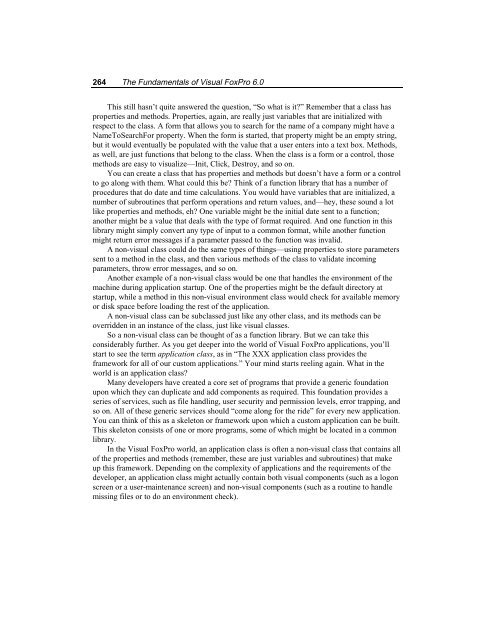Chapter 10 Using VFP's Object- Oriented Tools - dFPUG-Portal
Chapter 10 Using VFP's Object- Oriented Tools - dFPUG-Portal
Chapter 10 Using VFP's Object- Oriented Tools - dFPUG-Portal
You also want an ePaper? Increase the reach of your titles
YUMPU automatically turns print PDFs into web optimized ePapers that Google loves.
264 The Fundamentals of Visual FoxPro 6.0<br />
This still hasn’t quite answered the question, “So what is it?” Remember that a class has<br />
properties and methods. Properties, again, are really just variables that are initialized with<br />
respect to the class. A form that allows you to search for the name of a company might have a<br />
NameToSearchFor property. When the form is started, that property might be an empty string,<br />
but it would eventually be populated with the value that a user enters into a text box. Methods,<br />
as well, are just functions that belong to the class. When the class is a form or a control, those<br />
methods are easy to visualize—Init, Click, Destroy, and so on.<br />
You can create a class that has properties and methods but doesn’t have a form or a control<br />
to go along with them. What could this be? Think of a function library that has a number of<br />
procedures that do date and time calculations. You would have variables that are initialized, a<br />
number of subroutines that perform operations and return values, and—hey, these sound a lot<br />
like properties and methods, eh? One variable might be the initial date sent to a function;<br />
another might be a value that deals with the type of format required. And one function in this<br />
library might simply convert any type of input to a common format, while another function<br />
might return error messages if a parameter passed to the function was invalid.<br />
A non-visual class could do the same types of things—using properties to store parameters<br />
sent to a method in the class, and then various methods of the class to validate incoming<br />
parameters, throw error messages, and so on.<br />
Another example of a non-visual class would be one that handles the environment of the<br />
machine during application startup. One of the properties might be the default directory at<br />
startup, while a method in this non-visual environment class would check for available memory<br />
or disk space before loading the rest of the application.<br />
A non-visual class can be subclassed just like any other class, and its methods can be<br />
overridden in an instance of the class, just like visual classes.<br />
So a non-visual class can be thought of as a function library. But we can take this<br />
considerably further. As you get deeper into the world of Visual FoxPro applications, you’ll<br />
start to see the term application class, as in “The XXX application class provides the<br />
framework for all of our custom applications.” Your mind starts reeling again. What in the<br />
world is an application class?<br />
Many developers have created a core set of programs that provide a generic foundation<br />
upon which they can duplicate and add components as required. This foundation provides a<br />
series of services, such as file handling, user security and permission levels, error trapping, and<br />
so on. All of these generic services should “come along for the ride” for every new application.<br />
You can think of this as a skeleton or framework upon which a custom application can be built.<br />
This skeleton consists of one or more programs, some of which might be located in a common<br />
library.<br />
In the Visual FoxPro world, an application class is often a non-visual class that contains all<br />
of the properties and methods (remember, these are just variables and subroutines) that make<br />
up this framework. Depending on the complexity of applications and the requirements of the<br />
developer, an application class might actually contain both visual components (such as a logon<br />
screen or a user-maintenance screen) and non-visual components (such as a routine to handle<br />
missing files or to do an environment check).

















